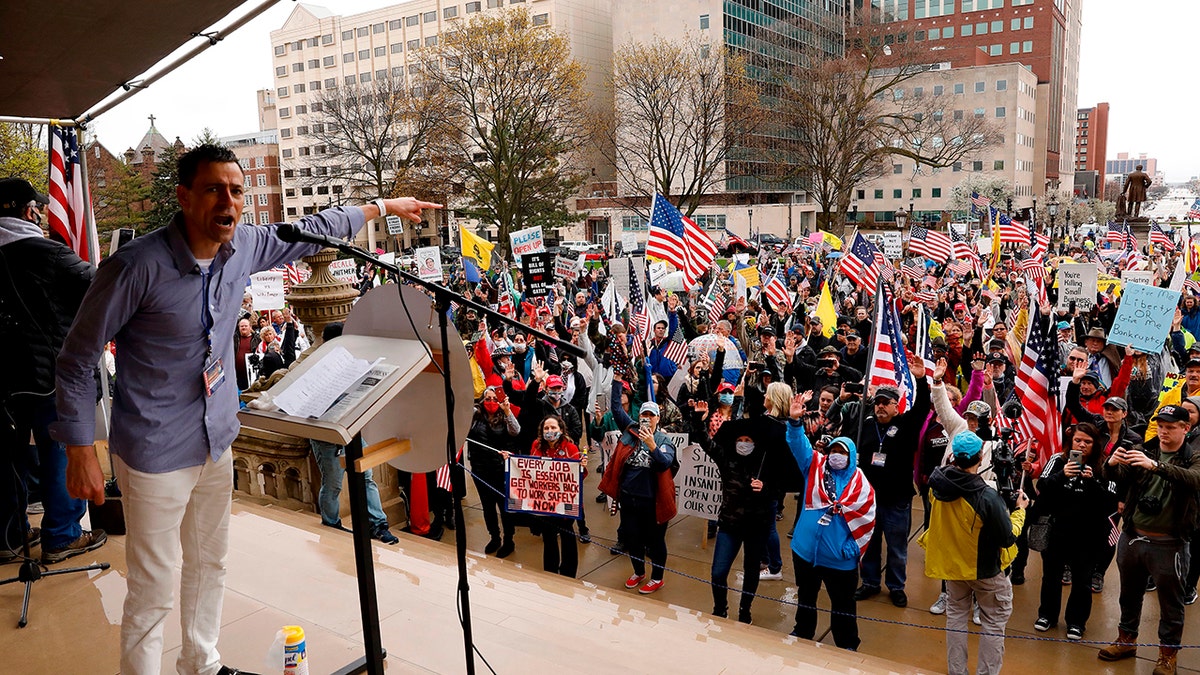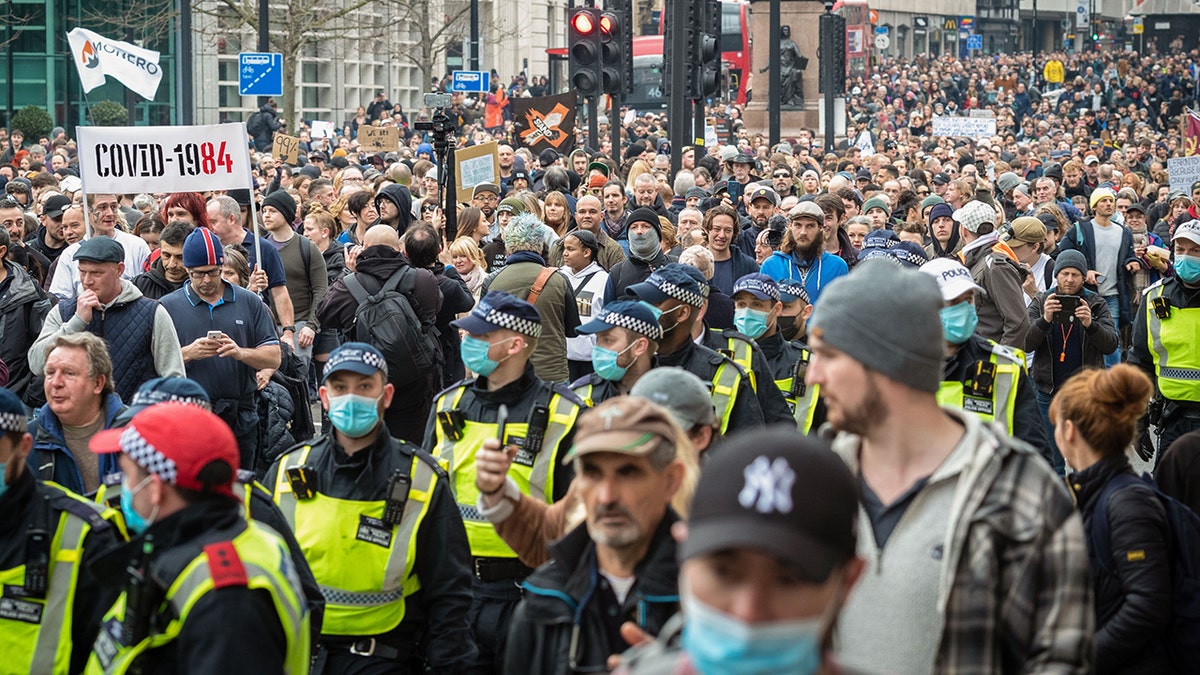China deploys riot police in hazmat suits to crack down on COVID protests
Riot police in Guangzhou, China, were deployed in hazmat suits to crack down on COVID-19 lockdown protests, in video obtained by Reuters.
Chinese protesting against the severe COVID restrictions by the Chinese Communist Party has received widespread praise and accolades from much of the media in the United States. However, when Americans protested COVID restrictions, the same media outlets struck a much different tone.
The New York Times published a story that highlighted the Chinese protestors' personal stories and the harm caused by Chinese President Xi Jinping's ‘Zero Covid’ policy.
"President Xi Jinping’s unbending approach to the pandemic has hurt businesses and strangled growth, squeezing the world’s second-largest economy," the Times reported Tuesday.
In a separate article, the Times lauded praise on young people protesting against the government's harsh lockdowns. "By standing up to the government, they defied the perception of their generation," the Times wrote.
AMERICAN COLLEGES JOIN GLOBAL PROTESTS AGAINST CHINA'S ANTI-COVID LOCKDOWN

People hold white sheets of paper in protest of coronavirus disease (COVID-19) restrictions, after a vigil for the victims of a fire in Urumqi, as outbreaks of the coronavirus disease continue in Beijing, China, November 27, 2022. REUTERS/Thomas Peter (REUTERS/Thomas Peter)
However, American protesters were not met with the same praise. Rather than highlighting the economic pain Americans faced during the government imposed lockdowns, articles published by the Times painted Americans who opposed such measures as extremists.
In May 2020, the Times published an article titled, "The Coronavirus Becomes a Battle Cry for U.S. Extremists".
"America’s extremists are attempting to turn the coronavirus pandemic into a potent recruiting tool both in the deep corners of the internet and on the streets of state capitals by twisting the public health crisis to bolster their white supremacist, anti-government agenda," the Times reported.
In a report published in April 2020, the New York Times described anti-lockdown demonstrations as "right-wing protests of social distancing restrictions". The Times used the term "right-wing protesters" in a headline for another article that month as well.
CHINESE POLICE FLOOD STREETS IN ATTEMPT TO CRACK DOWN ON INTENSIFYING PROTESTS

A person holds a banner during a protest in solidarity over the coronavirus disease (COVID-19) restrictions in mainland China, during a commemoration of the victims of a fire in Urumqi outside the Chinese consulate in Toronto, Ontario, Canada November 29, 2022. REUTERS/Chris Helgren
The Washington Post editorial board similarly treated Chinese protestors much more favorably than Americans. In April 2020, the editors described opposition to lockdowns as a "wide-ranging and well-financed conservative campaign to undermine restrictions that medical experts say are necessary to contain the coronavirus".
However, Monday, the editors sided with the protesters.
"Protests erupted in Chinese cities over the weekend, in which ordinary Chinese registered their unhappiness with their country’s strict coronavirus policies — and with the regime itself. A reasonable, responsive government would adjust," the editorial board wrote.

Ryan Kelley, a protest organizer, for the American Patriot Rally organized by the Michigan United for Liberty for the reopening of businesses stands on the steps of the Michigan State Capitol in Lansing, Michigan on April 30, 2020. - The group is upset with Michigan Gov. Gretchen Whitmer's mandatory closure to curtail Covid-19. ((Photo by JEFF KOWALSKY / AFP) (Photo by JEFF KOWALSKY/AFP via Getty Images))
The Guardian's coverage of anti-lockdown protests varied significantly, too. In May 2020, the media outlet published an article titled "US lockdown protests may have spread virus widely, cellphone data suggests." On Wednesday, their coverage of the Chinese protests was much more favorable, and even echoed the rallying cry of many Americans during the U.S. lockdowns.
"‘People want to live’: views from China on the Covid lockdown protests," the Guardian titled its recent article.
Rather than blaming Chinese protesters for spreading the virus, the publication praised the demonstrations as a "remarkable expression of defiance".

Protesters march on the street during the demonstration. Thousands of protesters take part in an anti-lockdown march. A World-Wide Rally for Freedom was organised a year after lockdowns were introduced to try and stop the spread of COVID-19. (Photo by Andy Barton/SOPA Images/LightRocket via Getty Images)
Other outlets, such as Vox, also have covered the concerns of the Chinese protesters much more favorably than their American counterparts. In March 2020, Vox published an article titled "The whiteness of anti-lockdown protests", which attempted to describe "[h]ow ignorance, privilege, and anti-black racism is driving white protesters to risk their lives."
However, Wednesday, Vox struck a very different tone. "Those of us in the West should listen to what’s being said by the brave protesters who’ve come out to the streets in China," they wrote.
CLICK HERE TO GET THE FOX NEWS APP
While less strict and severe than China's policies, government imposed coronavirus lockdowns in the U.S. had devastating economic, health, and educational consequences. Over 200,000 businesses closed permanently during the first year of the outbreak. Children are failing to meet basic reading, writing, and math standards. Healthcare workers who served during the pandemic and many others have since been let go because they elected not to receive the COVID-19 vaccine.





















